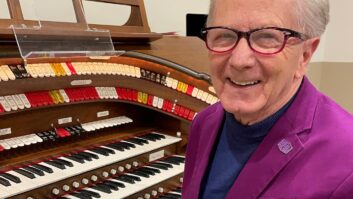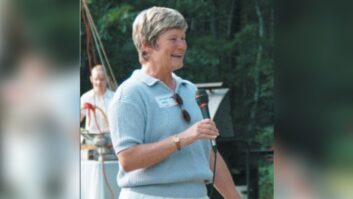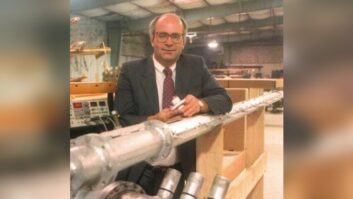
Ask any U.S. radio broadcast engineer above the age of 40 for the name most associated with “Cleburne, Texas.” They’ll be sure to answer:
Marti.
Iconic radio manufacturer George Marti has died at age 95, according to the Cleburne Times-Review.
Marti was indeed a central figure in that city — he was its long-time mayor, for one thing — but radio people know him for the remote pickup and studio/transmitter links he manufactured for many years.
His gear was so popular that for decades, his last name became both a common noun and verb— engineers who wanted to set up a remote broadcast and feed it back to the station would talk of doing a “Marti” or “Marti-ing” the signal back to the studio. An early Marti RPU is part of the collection of the Smithsonian’s National Museum of American History. In 1991, the National Association of Broadcasters honored George Marti with its Radio Engineering Achievement Award.
“Texas has lost a giant with the passing of George Marti,” stated TAB President Oscar Rodriguez, calling him “a man whose technical and business acumen changed the course of the broadcasting industry throughout the world and fueled scores of local, independent broadcast operations serving communities across the state.”
His career had many layers. “Marti was known as one of the county’s leading educational advocates,” the Cleburne Times-Review wrote today. “Through grants from the Marti Foundation, hundreds of students have earned college degrees. Marti was a renowned cattle fancier, having negotiated the first importation of Charolais livestock from Canada into the United States. He was famed for his accomplishments in radio. He owned a bank and served as Cleburne mayor for six terms. He also served in the Marine Corps. The Marti Elementary School, which opened in 2003, was named after Marti.”
It quoted current Mayor Scott Cain saying that Marti led the city during some hard times. “He had to personally guarantee payroll to see that the employers were paid.”
The Texas Association of Broadcasters awarded Marti its 2010 Lifetime Achievement Award. At the time it called him a “legendary Texas broadcaster.”
According to the TAB’s bio, Marti graduated from Central High School in Fort Worth at the age of 16 and attended technical school for nine months. He received his radiotelephone First Class and Amateur Radio licenses just prior to his 17th birthday (call letters: W5GLJ). TAB said Marti cited his grandmother as influencing him more than any other person.
“He spent time at her house each day on his way home from the two-room schoolhouse at Oak Grove. She told him when he was 12 that he needed to make a business plan. He decided that his plan would involve establishing a radio station in Cleburne.”
He worked in radio in the 1930s; in the Marine Corps studied in First Radar School at the Naval Research Lab in Washington. He and his wife Jo put KCLE(AM) on the air in Cleburne in the late 1940s; he built a 250-watt transmitter and audio console in his mother’s living room. Later he owned more stations.
He sold KCLE in 1960 and began making RPU and, later, STL gear.
“An RPU is a portable radio transmitter specially designed for use within a 10–15-mile radius from locations that lack broadcasting capability,” the Smithsonian wrote in 2013 when it added one to its collection. “A reporter covering a story in the field can use an RPU to transmit to a local radio station from which the signal is rebroadcast to the listening audience. Marti designed his first RPU in order to broadcast live the Cleburne High School football games.”
According to the TAB, “Before he designed and built the units and successfully lobbied the FCC to allow their use, radio stations had to use telephone lines that were expensive and not always reliable. His invention revolutionized the industry.”
Marti owned and operated Marti Electronics until 1994. Broadcast Electronics purchased it and, according to Radio World coverage at the time, moved Marti manufacturing operations to Illinois in 2003.
In the early 1990s, Marti and Jo purchased the Bank of Cleburne and owned it for five years, eventually merging it with another financial entity. The couple also created the Marti Foundation, which funded $10,000 scholarships to help local graduates attend college.
Marti received TAB’s Pioneer Broadcaster of the Year Award. He was inducted into the Texas Radio Hall of Fame in 2002.
Jo died in 2003, according to a Radio World story at the time. Marti remarried his wife Margaret in 2004, according to the TAB bio.
“I first met George back in 1988,” said Lee Edwards, sales engineer for ProAudio.com, told Radio World today. “What a wonderful man he was. One of the nicest men this industry ever saw.”
Read more about George Marti and the role of the equipment he made:
This Pot Reserved for Marti Remote (2005)












